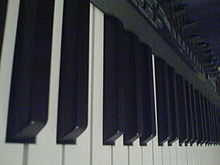- Chordboard
-
File:ChordboardPhase2.pngA Chordboard conceptual standd alone unit
The chordboard is an electronic musical instrument based on software technology, and played by keyboard controller, one implementation being a set of four MIDI keyboards arranged vertically. The patent[1] for this musical technology specifically identifies the seven chords that exist for each key signature, and how these key signatures can be selected at any time while playing the instrument to achieve a key signature change, and thus an instant change in chords. In every key signature there are seven chords, and each of these chords are identified on the chordboard as follows (signified by Nashville Notation):
- I chord is major tonality, referred to as ROOT CHORD
- ii chord is minor tonality, referred to as SUPER TONIC CHORD
- iii chord is minor tonality, referred to as MEDIANT CHORD
- IV chord is minor tonality, referred to as SUB-DOMINANT CHORD
- V chord is minor tonality, referred to as DOMINANT CHORD
- vi chord is minor tonality, referred to as SUB-MEDIANT CHORD
- vii chord is minor tonality, referred to as LEADING TONE CHORD
Pressing a key on any one of the chordboard's four keyboards will cause a single note to be heard within the chord zone played. Each key will play only one note. In order to play a chord, two or more keys must be played, similar to a piano. Chords are played by playing two or more keys at the same time.
Contents
History
The chordboard original started as a prototype stand alone self-contained unit[2], but evolved into a software based musical instrument that could work with a variety of hardware devices, as music technology has continually evolved centered around a DAW. With the advent of readily available Digital Audio Workstation (DAW) easily accessible to the consumer masses on account of much lower cost options (with some being freely available ie Audacity[3]), the chordboard can be configured using any type of MIDI keyboard connected via USB to a MAC or PC computer.
Functionality
Large symphonic chord voicings can be played on the chordboard[4] with 12 notes available for each of the seven chord zones (84 active notes total). Each white key on the MIDI keyboard used represents an individual note within a chord zone, and is mapped to a note within a harmonic chord voicing pattern programmed for each chord, according to major-minor tonality and a particular voicing style (such as classic, jazz, or oriental). Due to the chord voicing mapping that takes place within the software, the entry level learning curve is short. In contrast, because of the millions of possible chord voicings between each of the seven chords in a key signature, more advanced level playing technique can take place, but over a much longer period of time.
The chordboard interface is made up of 7 different active chords, with the option to change chord values based on every possible key signature variation (24 unique sets of key signatures, 12 major and 12 minor each in the keys of C, Db, D, Eb, E, F, Gb, G, Ab, A, Bb, B). Each chord value can instantly change depending on which key signature is selected from the top keyboard in the stack of four MIDI keyboards. For example, in the Key of C, the 1 chord is the C major chord, and the ii chord is D minor, and so on up the scale. The chordboard allows the player to select key signature changes on the fly, and chord style, or genre changes also on the fly, facilitating a vast variety of chord voicings available for each chord.
References and notes
- ^ "Chordboard CX10". United States Patent and Trademark Office. August 8, 1995. http://patft.uspto.gov/netacgi/nph-Parser?Sect1=PTO2&Sect2=HITOFF&p=1&u=%2Fnetahtml%2FPTO%2Fsearch-bool.html&r=40&f=G&l=50&co1=AND&d=PTXT&s1=cx10&OS=cx10&RS=cx10.
- ^ "Wayback Machine record of chordboard". waybackmachine. Feb 14, 1998. http://replay.waybackmachine.org/19980214070800/http://www.chordboard.com/. Retrieved Mar 13, 2011.
- ^ "SourceForge.net: All-Time Top Downloads". http://sourceforge.net/top/topalltime.php?type=downloads. Retrieved 29 October 2010.
- ^ "Chordboard functionality". chordboard. http://chordboard.com/index_files/customesupportrindex.htm.
External links
Categories:- Electronic musical instruments
- Keyboard instruments
Wikimedia Foundation. 2010.

